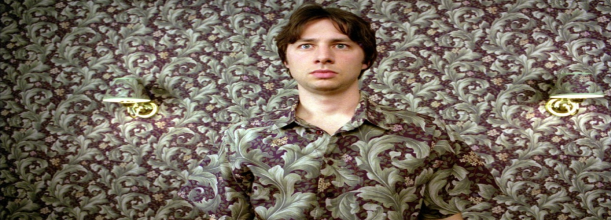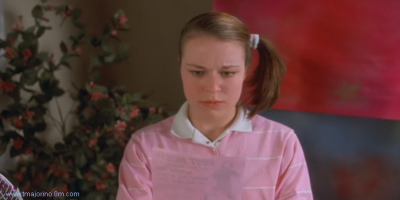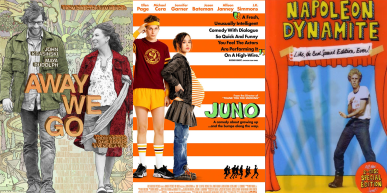Top 10 Indie Film Clichés

Something has happened to the word “indie”, of late. It’s been stolen from its rightful place, and thrown over any film that contains retro trainers, an air of deadpan comedy and a title that looks like it’s been sketched with pencil. You don’t fool us, ‘indie’ films, you may look like you’ve been made on a shoe string but we know the real you. Here are the top 10 characteristics that suddenly make any film ‘indie’.
10. The use of high profile actors where you wouldn’t expect them
Indie films are fertile ground for famous actors looking to add something a little more edgy to their CV. If a film that is genuinely independent can hook a high profile actor into its cast, it stands a much bigger chance of getting watched. In Lymelife we see Sex and The City’s Cynthia Nixon attempt to rid herself of the damage the TV show’s done to her career, and Alex Baldwin jumps in in an attempt to…no, I can’t say a bad thing about him. He’s just cool.
Other great examples of this are Natalie Portman in Garden State and Will Ferrell in the upcoming Everything Must Go.
9. Overly intelligent language, or stylish vocabulary.
Indie films love to throw in little nuggets of academic flair. No film portrays this quite as much as Igby Goes Down. Just a brief introduction is laden with pretention:
Igby: “Oliver is majoring in neo-fascism at Columbia.”
Oliver: “Economics.”
Igby: “Semantics”.
Oh how wry and witty. You’ve got to give it to Brick, though. They take some brilliant noir-esque language and turn it into modern nonsense. It’s pretty hard to figure out:
Brendan: “No, bulls would gum it. They’d flash their dusty standards at the wide-eyes and probably find some yegg to pin, probably even the right one. But they’d trample the real tracks and scare the real players back into their holes, and if we’re doing this I want the whole story. No cops, not for a bit.”
8. Life-affirming, off beat, indie music.
You just need to watch the trailer to Everything Must Go to see this. The first song actually bellows out the line: “standing at the door of self discovery”. As if we needed any more hints that the film is about a humdrum life being turned on its head, but with a surprisingly positive outcome. Wes Anderson films indulge these kinds of songs more than most. Not quite indie, but the Kinks’ “This Time Tomorrow” used in The Darjeeling Limited is a perfect example of a song being used to express the characters’ uncertain lives. Ah.
7. Retro clothing, ambiguous style periods.

Napoleon Dynamite sets the bar for this one. The whole style of the film is vaguely 80s, with big hair and hideous dresses, tight jeans and bad moustaches. Yet it is never clear when it’s set, and one of the characters even chats online with girls. Intriguing… Again, Wes Anderson films are so difficult to pin down time wise, and often have the characters dressed in vintage style clothes that could be 70s, 80s 90s or, God, now even. Who knows? Richard Ayoade purposefully made his film Submarine look like it was simply in the vague past. Really helpful guys.
6. The Mid-life crisis

Tying nicely in with the life-affirming music is the mid-life crisis; the general life troubles and the gosh darn ennui. Indie films aren’t about superheroes, or about a specific event. They’re all over-arching and profound and what-not; simple stories about a guy trying to get with a girl, getting divorced or finding himself. God, what is Greenberg about? A slighty weird guy with no job that kind of falls in love with a girl. Exciting stuff!
5. Pointy Font
As we’ve just mentioned above, the font seems to be a big deal for indie films. It’s got to look rough, almost childish and, most importantly, be THIS EXACT FONT:

Don’t believe us? Check it out.

It’s quirky, it’s kooky, it makes it look arty, but in a crap way. Yep, it’s a title that says “come on over kids, or mildly immature adults. We’re fun, but meaningful. Like Lego. “
4. The loveable geek/ loser

Ok, you saw this one coming, right? Was it the subtle Michael Cera joke above that gave it away?
Well, he has patented the loveable, awkward geek role and made it his own, that was until Jesse Eisenberg came along and did roughly the same thing in Adventureland. In Juno and Youth In Revolt Cera is the same person. But we can’t put the blame solely on Michael. Napoleon Dynamite took it a couple hundred steps further (and back in time, possibly?). Paul Giamatti has a pop the more refined adult loser in Sideways. Most people in Indie films are losers because they’re subversive, man, they’re going against the grain and will ultimately be cooler than everyone else, just like a, well, indie film. Or, perhaps the writers are just writing about themselves?
3. The Manic-Pixie-Dream-girl

This is a long established role in film, but particularly indie films. Or, rather, films that are trying to be indie. Take The Last Kiss for example, as terrible a film as it is, it enlists the help of a loveable, life-grabbing, pint-sized hotty to shake things up in Zach Braff’s dull life. In fact, that’s exactly what Natalie Portman does in Garden State too. What is it about Zach Braff? Ellen Page’s Juno ticks the manic and pixie boxes, but is a little too in your face for the dream girl part. But hitting the nail on the head, and showing the darker side to the MPD’s is Zooey Deschanel’s character in 500 Days of Summer. They’re pretty, but they’re dangerous. watchyaselves.
2. Long shots of American Suburbia
Juno is quite possibly the king (or Queen, rather) of this. There are multiple moments in the film that are simply shots of the running team jogging around the neighbourhood. Michael Cera simply has to pop outside his door and he’ll join on the end of the running line. It’s trying to suggest a ridiculous level of monotony, whilst making up some cute foibles of suburban life. The opening to Donnie Darko is another example, although it’s much more in favour of setting up the film, where we’re really getting told YOU ARE IN AMERICAN SUBURBIA. To quote Lymelife: “Welcome to our wonderful little family in our perfect little suburban life”. Thanks guys, what a lovely summing up of your irony.
1. Family
And finally we have the family. This ties in with a lot of the other characteristics. You can loosely make most things about family, but due to indie movies being set in suburbia, often including mid-life crises and some kind of life affirming event, it’s safe to say that family comes into it a lot. Most of the films we’ve talked about are based around it: Garden State, Juno (in more ways than one), Napoleon Dynamite, The Darjeeling Limited and definitely Lymelife. If they’re not directly to do with an odd-ball family they’ll include a makeshift one, made up of stupid mates, a pet dog and maybe a profound, insightful parrot or something. Gosh, aren’t indie films just bloody delightful?






Recent Comments